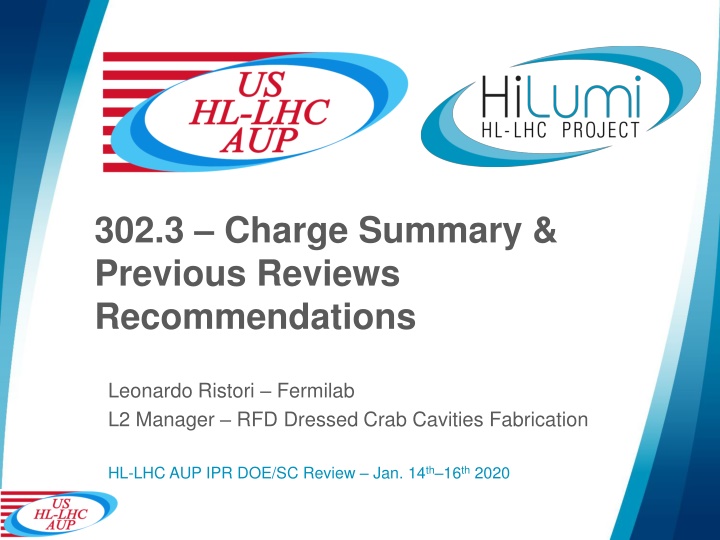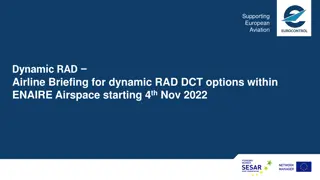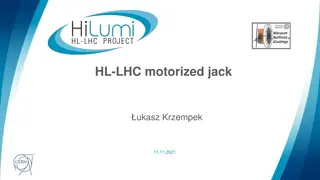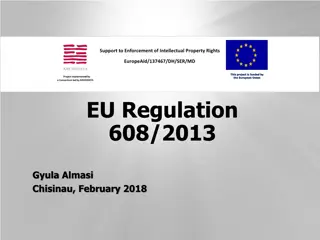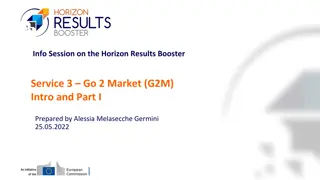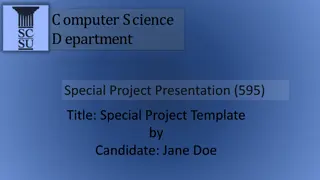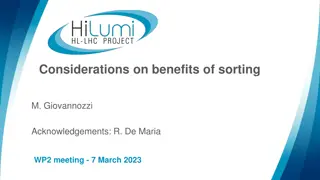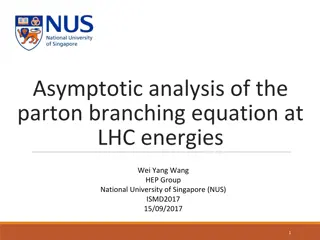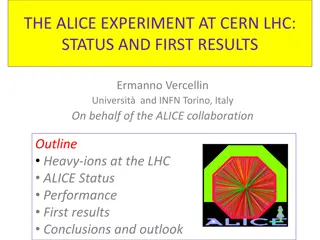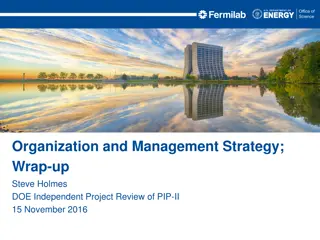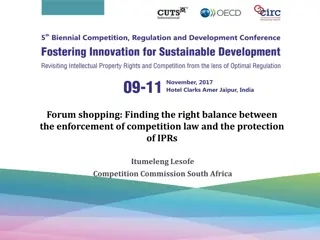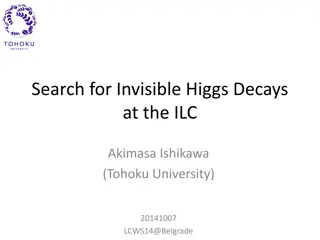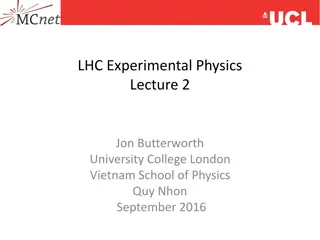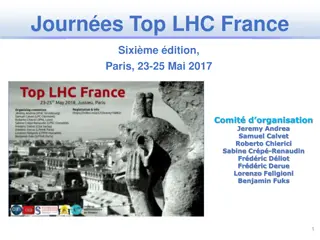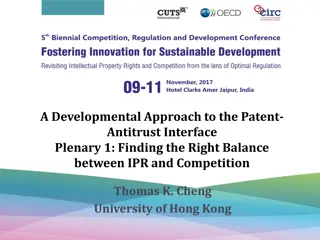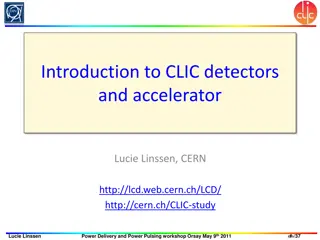Project Review and Recommendations for HL-LHC AUP IPR DOE/SC Review
Summary of project reviews and recommendations for the High-Luminosity Large Hadron Collider (HL-LHC) Accelerator Upgrade Project (AUP) during the DOE/SC Review in January 2020. Covers technical progress, schedule management, external dependencies, and procurement management. Emphasis on project completeness, performance parameters, resource utilization, and risk analysis. Overall, the project shows strong progress and adherence to key performance parameters.
Download Presentation

Please find below an Image/Link to download the presentation.
The content on the website is provided AS IS for your information and personal use only. It may not be sold, licensed, or shared on other websites without obtaining consent from the author.If you encounter any issues during the download, it is possible that the publisher has removed the file from their server.
You are allowed to download the files provided on this website for personal or commercial use, subject to the condition that they are used lawfully. All files are the property of their respective owners.
The content on the website is provided AS IS for your information and personal use only. It may not be sold, licensed, or shared on other websites without obtaining consent from the author.
E N D
Presentation Transcript
302.3 Charge Summary & Previous Reviews Recommendations Leonardo Ristori Fermilab L2 Manager RFD Dressed Crab Cavities Fabrication HL-LHC AUP IPR DOE/SC Review Jan. 14th 16th2020
Summary/Charge Questions for Jan. 20 IPR Charge 1: Is the project making adequate technical progress to ensure that the completed project will perform as planned and the key performance parameters will be met ? Direct measurements of the performance of LARP RFD Cavities satisfy the Q0and Field Acceptance Criteria. Quality of Niobium parts, of machining and of electron- beam welding at E. Zanon is better than the LARP prototypes. KPPs clearly define project completeness and have been accepted by CERN. HL-LHC AUP IPR DOE/SC Review Jan 14-16, 2020 2
Summary/Charge Questions for CD-2/3b Charge 2: Are the resource-loaded schedule and the estimate-to-complete up-to-date, accurate and credible ? Is the project on track to advance to the next gate decisions ? The RLS is complete, consistent and credible to achieve the KPPs. The RLS is actively used to manage the activities and track milestones to ascertain progress. Several tools are used to manage and keep the RLS up-to- date: baseline change requests, risk management and EAC updates. All known changes are included in the reported EAC. A bottoms-up EAC revision will be conducted in Feb.-Mar. 2020 before the FNAL Annual EVMS Surveillance Review L. Stapleton presentation HL-LHC AUP IPR DOE/SC Review Jan 14-16, 2020 3
Summary/Charge Questions for CD-2/3b Charge 3: Does the project understand its dependencies on outside resources such as international collaborators, funding from other agencies and participation by researchers with other funding sources ? The only external dependencies are from CERN External Milestones are heavily used in the RLS to monitor the external dependencies. Tight interactions/visits by appropriate AUP L2/L3 heighten sense of awareness. Threat in risk register specific for delays from CERN in delivery of functional drawings It is part of the (DRAFT) FNAL-CERN MOU for the execution of AUP to address major issues through the FNAL-CERN HL-LHC Steering Committee HL-LHC AUP IPR DOE/SC Review Jan 14-16, 2020 4
Summary/Charge Questions for CD-2 Charge 4: Are the major procurements being managed successfully ? CD-3a and CD-3b major and significant procurements are actively and properly managed Raw Niobium procurement for Pre-Series successfully complete. Series: Imminent. Bare Cavity procurement of Prototypes proceeding well under tight surveillance by AUP representatives with visits every 1-2 months, conference calls every week, and daily email exchange. Charge 5: Is Environment, Safety and Health being handled properly ? Safety has paramount importance in the execution of AUP No incidents or near-misses related to AUP activities Charge 6: Has the risk analysis been updated to reflect the real risks for completing the project and are the contingencies acceptable ? Yes. Risk actively managed on monthly basis Charge 7: Has the project satisfactorily responded to the recommendations from the previous reviews ? Recommendations Response document has been provided (US-HiLumi-dc-1322) M. Wodzinski presentation A. Pavnica presentation A. Hemmati presentation HL-LHC AUP IPR DOE/SC Review Jan 14-16, 2020 5
Charge 7 Recommendations from Previous Reviews US-HiLumi-doc-1322 Review Recommendations Closed Open Anticipated Closure CD-1/3a (Aug 2017) 4 4 0 Design Freeze (Mar 2018) 4 4 0 PDR/FDR (Jun 2018) 3 2 1 Jul 20201 Dir CD-2/3b (Jul 2018) 5 4 1 Feb 20202 CD-2/3b (Dec 2018) 6 4 2 Jul 20203, Dec 20214 TOTALS 22 18 4 Recommendation Tracking Table contains all recommendations and responses: US-HiLumi-doc-1322 Not discussing here recommendation already closed at previous CD-2/3b review and positive recommendations (e.g. proceed ) HL-LHC AUP IPR DOE/SC Review Jan 14-16, 2020 6
PDR/FDR 20-21 June 2018 CAV-PDR-1: Develop and document, in the acceptance tests of the fully dressed cavities [at FNAL in VTS], a standard way to qualify the performance of the HOM dampers in the finished cavity. CLOSED - Document created "RFD Dressed Cavity HOM coupler qualification tests" US-HiLumi-doc-2581. Acceptance tests will be in accordance with this document. CAV-PDR-2: Hold a technical design review of the entire dressed cavity, including helium vessel and magnetic shielding, once the design of those components are complete, to re-assess whether the design verification scheme can confirm the performance of the AUP deliverables, prior to CD-3. IN THE PLAN - A Final Design Review by an external team, organized by AUP at FNAL is planned in Summer 2020 before CD-3c. CAV-PDR-3: Consult with Fermilab import/export experts prior to placing a PO after the CD-3b approval. CLOSED Consulted experts, itemized import fees and placed PO. First batch of materials received early and without import surprises . HL-LHC AUP IPR DOE/SC Review Jan 14-16, 2020 7
Director CD-2/3b 18-20 July 2018 D-CD2/3b-4: Finalize requirements associated with magnetic shielding in advance of the RFD final design review. Define the required ambient field level at the RF cavity surface with a justification based on the cavity Q0specification. IN THE PLAN - Revision of FRS includes magnetic shielding requirements. Advanced draft in discussion between AUP/CERN. Approval Jan-Feb 2020 D-CD2/3b-5: Perform transportation analysis of the assembled RFD with anticipated transportation loads in advance of the RFD final design review. Pay particular attention to the HOM dampers and field probe antenna. Special shipping configuration may be required if risks are deemed too high. CLOSED - Transportation analysis completed "RFD Cavity Ancillaries Transportation Analyses" US-HiLumi-doc-2587. No issues up to 10G 30ms (above requirement of 7.5G 11ms). HL-LHC AUP IPR DOE/SC Review Jan 14-16, 2020 8
DOE CD-2/3b Review 11-13 Dec 2018 CD2/3b-3: Perform a dressed cavity test in a cryostat at the earliest opportunity to validate the design. OPEN - Cryostat tests, and facility upgrades are not in the baseline. Facilities would need to be upgraded to accommodate a test of this new type of cavity. First cryostat test at CERN on a dressed RFD cavity is foreseen in Dec 2021. CD2/3b-5: Before CD-3c (before Aug 2020) complete the following: a) Hold a Final Design Review of dressed RFD Crab Cavities. Planned b) Revisit/Reevaluate thermal analysis of FPC and HOM couplers to ensure that the heat leakage does not exceed the total cryogenic limit. Ongoing at CERN (estimated Spring 2020) c) Develop a detailed heat load table for the fully dressed cavity and ancillary. Ongoing at CERN (estimated Spring 2020) d) Clearly define the acceptance criteria for the dressed cavities with CERN. This should include any performance validation testing after shipping from FNAL to CERN/TRIUMF. Drafts of Acceptance Plan and Acceptance Criteria prepared in 2018-2019 and shared with CERN in multiple occasions. Performance validation document for tests at TRIUMF does not yet exist. Convergence needed in early 2020 certainly before Final Design Review HL-LHC AUP IPR DOE/SC Review Jan 14-16, 2020 9
Summary HL-LHC AUP IPR DOE/SC Review Jan 14-16, 2020 10
